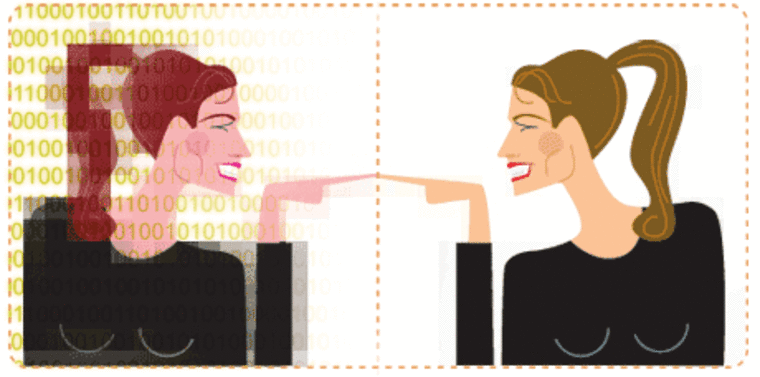Jan. 15, 2022 -- For nearly a decade, replica synthespians have delighted moviegoers worldwide. From the $9 billion dollar worldwide bonanza of the “Bruce Lee Reborn” series to the critical huzzahs for the young Humphrey Bogart and Lauren Bacall in Sofia Coppola’s stylish remake of “Before Sunrise,” audiences have gobbled up these costly digital confections.
But history was made last week as Pixar-Dreamworks-Universal announced the details of the long-rumored “Love and Kisses” project starring the reclusive Hollywood legend Julia Roberts. For the first time a living actor will actually co-star with their own replica.
We caught up with Roberts at her home in her Hollywood Hills post-quake villa to talk about her first picture in nearly a decade and this bold experiment in sharing the screen with a younger self.
Q: Most actresses would be pretty worried about appearing alongside a much younger version of themselves.
Roberts: Well, we won’t actually appear on screen at the same time. My character, Amanda, is looking back on her life, so the story will alternate back and forth.
But even so—this has got to be a pretty strange experience for you. And it’s quite a risk also.
First of all, I would never have even thought about this if it hadn’t been justified artistically. But the script is so wonderful that I just had to play both Amandas. And from there, as I talked to the studio, and especially to Steve Jobs, who has been terrific about walking me through all this technology, it just started to make sense.
Are you going to wear the replica suit to play young Amanda yourself?
Oh, absolutely. Since it’s the same character, the body frame and physical movements will be the same so it makes sense for me to play young Amanda also. I will need to do some training, mostly flexibility work, just to make sure my walking and so forth are age appropriate.
What’s the replica suit like?
(Laughs) Uh, if you can imagine a combination of a scuba wetsuit and some kind of medical device. ... I mean, the suit itself is wireless, but there are still like 65,000 individual location sensors and they’re all connected together by this wiring harness that runs under the fabric. It feels very, very weird. And for some reason it’s not very breathable so they have to keep the set chilled. But once you’re in the scene you forget about it.
Which of your movies will the younger Amanda come from?
Amanda’s “skin” — that’s what they call it — will be generated out of “Pretty Woman”. I was 21 when I made that film and that happens to be the younger Amanda’ age in “Love and Kisses.” In the original script there was actually a part for a 35-year-old Amanda also, but that got cut.
Thirty-five. So, that could have been you in “Closer.”
(Laughs) I haven’t thought about that film in years. They cut out the 35 year old Amanda — and the producers will probably kill me for saying this — because it’s so expensive to do even one of these replica-based synthespians that there just wasn’t budget for two. Lots of people don’t know that it costs a lot more to do a replica-based synthespian than a fully synthetic one. Software works very cheap.
So could you find yourself nominated for an Oscar in both lead and supporting categories next year?
I wish. I’m not sure about the Academy rules on virtual performance; they might make an exception, since it’s all my image. But since the skin comes from an earlier performance, that probably disqualifies me. Of course, as young Amanda I would be eligible in the Special Effects Performer category, but that’s very competitive — those are actors who have doing this for years.
What’s your favorite synthespian performance?
I would have to say ... Gloria Arredondo as Charlie Chaplin in the remake of Modern Times. She had the body language down just perfectly. But I’m not really a fan of the full synthetics. I just don’t think a completely synthesized actor is quite the same as one generated by a real actor wearing a replica suit. I know producers love full synthetic for cost reasons and some of the young directors aren’t that comfortable with actors. But I think there will always be a place for real actors, whether they are playing themselves or animating a synthespian.
Then what do you think of the “pure analog” movement in Europe?
Well, I think it’s very sweet and very idealistic, and I know there’s a high-end audience for those productions. But it’s enormously expensive and time-consuming to make a film that way. To get that “never digitized” label you have to use chemical film, and edit manually, and ... I don’t see the difference on screen. But some people do, and they’re willing to pay those ticket prices. But you know, all those techniques are really ancient history now, and I just don’t think it’s healthy to relive the past.
